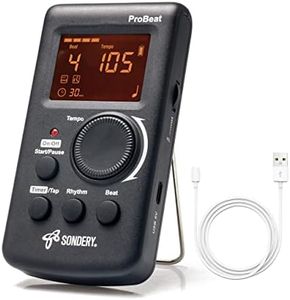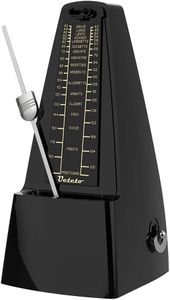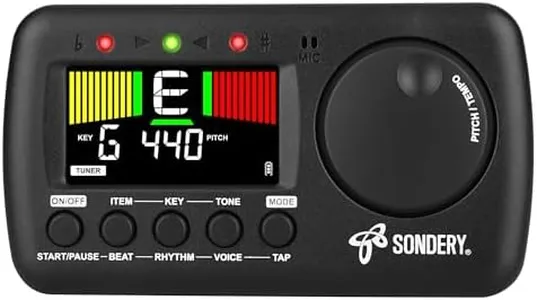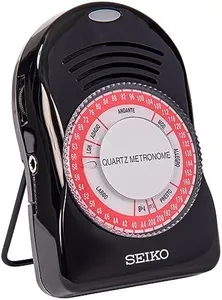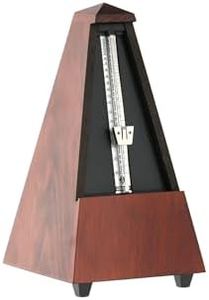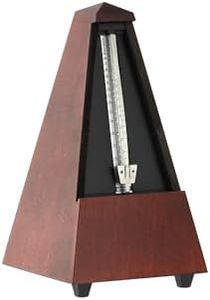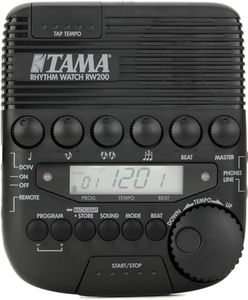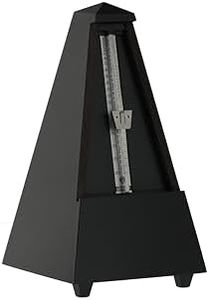10 Best Metronomes 2025 in the United States
Our technology thoroughly searches through the online shopping world, reviewing hundreds of sites. We then process and analyze this information, updating in real-time to bring you the latest top-rated products. This way, you always get the best and most current options available.

Our Top Picks
Winner
Sondery Digital Metronome Rechargeable English Vocal Counting with Timer Function for Piano Guitar Drum and All Instruments
Most important from
1827 reviews
The Sondery Digital Metronome offers a wide tempo range from 40 to 208 bpm, catering to most musical needs. It includes three sound options and vocal counting, which can be particularly useful for beginners who need clear audio guidance. The metronome also features volume control through a loud speaker, ensuring it can be heard during practice, and it includes an earphone jack for quiet sessions, making it versatile for different environments.
Visual indicators like the LED light provide an additional cue to help keep time, which is useful for practicing in noisy settings or during live performance. The metronome supports multiple rhythm patterns, allowing for diverse rhythm training. Portability is well addressed with its small size and light weight, making it easy to carry around. Rechargeable via USB, it eliminates the need for frequent battery replacements, which is convenient.
Additional features like a timer function and tap tempo enable customized practice sessions and ease of use. However, the plastic build might not feel as premium, and users who prefer tactile feedback might find the buttons and knobs less satisfying compared to traditional metronomes. Also, while the vocal counting is a great feature, it might not be indispensable for advanced users. The Sondery Digital Metronome is an excellent tool for musicians who need a reliable, portable, and versatile metronome with modern features.
Most important from
1827 reviews
Ueteto Mechanical Metronome Black/Loud Sound Piano Drum Violin Guitar
Most important from
2148 reviews
The Ueteto Mechanical Metronome is a classic wind-up device designed to help musicians keep a steady tempo while practicing various instruments like piano, guitar, violin, and drums. Its tempo range of 40 to 208 beats per minute covers most musical needs, and it offers beat selections including 2, 3, 4, and 6 beats per measure, which adds flexibility for different rhythms. One of its strengths is that it requires no batteries, running on a mechanical wind-up mechanism that lasts about 18 minutes per full wind, which is convenient and eco-friendly. The metronome produces a loud, clear click and bell sound, making it easy to hear during practice sessions.
Its design is relatively portable at just over a pound and compact size, so it's easy to carry around or fit on a music stand. Visual indicators like the swinging pendulum help users follow the beat visually, which is helpful especially for beginners or children. However, being purely mechanical means it doesn’t offer volume control or a variety of sound options like digital metronomes do. Also, while it’s durable and simple to operate, some users may find setting the tempo less precise compared to digital alternatives.
This metronome represents a solid choice for musicians looking for a reliable, traditional, and battery-free tool to develop rhythm and timing skills without extra digital features.
Most important from
2148 reviews
Soundbrenner Pulse, Vibrating Metronome for All Musicians and Instruments, Perfect for Drums, Guitar, Piano and More, Best in Show at NAMM
Most important from
1251 reviews
The Soundbrenner Pulse is a unique vibrating metronome designed for musicians who want to feel the beat rather than just hear it. It offers a wide tempo range controlled through an intuitive dial and tap features, making it easy to adjust on the fly. Instead of traditional click sounds, it uses strong vibrations—about seven times stronger than those in most smartphones—allowing you to stay in rhythm without distracting noise. This is great for noisy environments or for musicians who prefer a silent metronome. It also includes LED lights synced to the beat, which can be customized or turned off if preferred.
The companion app adds a lot of flexibility, letting you set time signatures, subdivisions, and accents, save presets, and even sync multiple devices for group practice. It can also connect with music production software via MIDI or Ableton Link, though this feature is still in beta. Battery life is solid, providing over 6 hours of use, and the device is lightweight and portable, designed to be worn on various body parts for maximum feel.
Some users might need time to adjust since the device relies on vibrations and LEDs rather than traditional sound clicks. While the app offers some volume control through sound options, the metronome itself is silent unless connected to external devices for sound. Additionally, the use of a CR2 battery means it must be replaced rather than recharged, which may be less convenient for some.
